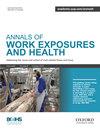222c - Human biomonitoring of neonicotinoid insecticides in environmental and occupational settings
IF 1.8
4区 医学
Q3 PUBLIC, ENVIRONMENTAL & OCCUPATIONAL HEALTH
引用次数: 0
Abstract
Neonicotinoid insecticides and neonicotinoid-like compounds (NNIs) are the most widely used insecticides in the world, accounting for over 25% of the insecticide market. In recent years, NNIs have been identified as potential hazards to humans and are included in chemical priority lists in the European Union, the United States, and Canada. However, NNIs such as acetamiprid and flupyradifurone, are still widely used as plant protection products throughout the EU. Additionally, imidacloprid is still used as a flea treatment for cats, dogs and other pets. Human biomonitoring allows for a quantitative assessment of internal chemical exposures by analysing biological media. Despite growing concern about the hazardous properties of NNIs, there have only been a few human biomonitoring (HBM) studies investigating NNI exposures conducted in the EU and none in Ireland. The EIRE ‘nEonicotinoid Insecticide exposuREs’ project is a human biomonitoring study investigating exposures to NNIs among the general population and occupational users of NNIs in Ireland. Urine samples from the general Irish population (n=227) were analysed for seven major NNIs using LC-MS/MS Of those samples, 76% had quantifiable levels of at least one NNI, indicating a potential for widespread exposure of NNIs among the Irish population. An occupational study of professional gardeners and pet shelter workers who use NNIs will commence in 2024. Preliminary results from the general Irish population study and the recruitment strategy for the occupational studies of professional gardeners and pet shelter workers will be presented.222c - 新烟碱类杀虫剂在环境和职业环境中的人体生物监测
新烟碱类杀虫剂和新烟碱类化合物(NNIs)是世界上使用最广泛的杀虫剂,占杀虫剂市场的 25% 以上。近年来,新烟碱类化合物已被确认为对人类有潜在危害,并被列入欧盟、美国和加拿大的化学品优先清单。然而,啶虫脒和氟虫脲等腈菌茚类杀虫剂在欧盟仍被广泛用作植物保护产品。此外,吡虫啉仍被用作猫、狗和其他宠物的跳蚤治疗剂。人体生物监测可通过分析生物介质对体内化学品暴露进行定量评估。尽管人们对 NNIs 的危险特性日益关注,但欧盟仅开展了几项人体生物监测 (HBM) 研究,调查 NNIs 暴露情况,爱尔兰尚未开展任何研究。爱尔兰环境研究所的 "NEonicotinoid Insecticide exposuREs "项目是一项人体生物监测研究,旨在调查爱尔兰普通人群和 NNIs 职业使用者的 NNIs 暴露情况。使用 LC-MS/MS 分析了爱尔兰普通人群(n=227)的尿液样本中的七种主要非壬基烷烃,其中 76% 的样本中至少含有一种可量化的非壬基烷烃,这表明爱尔兰人群可能广泛接触非壬基烷烃。一项针对使用 NNIs 的专业园丁和宠物收容所工作人员的职业研究将于 2024 年开始。届时将介绍爱尔兰普通人群研究的初步结果,以及职业园丁和宠物收容所工作人员职业研究的招募策略。
本文章由计算机程序翻译,如有差异,请以英文原文为准。
求助全文
约1分钟内获得全文
求助全文
来源期刊

Annals Of Work Exposures and Health
Medicine-Public Health, Environmental and Occupational Health
CiteScore
4.60
自引率
19.20%
发文量
79
期刊介绍:
About the Journal
Annals of Work Exposures and Health is dedicated to presenting advances in exposure science supporting the recognition, quantification, and control of exposures at work, and epidemiological studies on their effects on human health and well-being. A key question we apply to submission is, "Is this paper going to help readers better understand, quantify, and control conditions at work that adversely or positively affect health and well-being?"
We are interested in high quality scientific research addressing:
the quantification of work exposures, including chemical, biological, physical, biomechanical, and psychosocial, and the elements of work organization giving rise to such exposures;
the relationship between these exposures and the acute and chronic health consequences for those exposed and their families and communities;
populations at special risk of work-related exposures including women, under-represented minorities, immigrants, and other vulnerable groups such as temporary, contingent and informal sector workers;
the effectiveness of interventions addressing exposure and risk including production technologies, work process engineering, and personal protective systems;
policies and management approaches to reduce risk and improve health and well-being among workers, their families or communities;
methodologies and mechanisms that underlie the quantification and/or control of exposure and risk.
There is heavy pressure on space in the journal, and the above interests mean that we do not usually publish papers that simply report local conditions without generalizable results. We are also unlikely to publish reports on human health and well-being without information on the work exposure characteristics giving rise to the effects. We particularly welcome contributions from scientists based in, or addressing conditions in, developing economies that fall within the above scope.
 求助内容:
求助内容: 应助结果提醒方式:
应助结果提醒方式:


